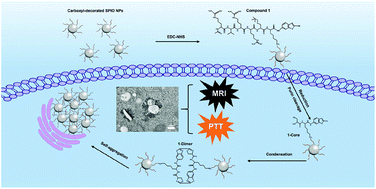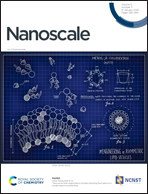Enzyme-instructed self-aggregation of Fe3O4 nanoparticles for enhanced MRI T2 imaging and photothermal therapy of tumors†
Abstract
The aggregation of superparamagnetic iron oxide (SPIO) nanoparticles (NPs) can greatly enhance magnetic resonance imaging (MRI) T2-weighted imaging and near-infrared (NIR) absorption in experiments. In this study, an Ac-Arg-Val-Arg-Arg-Cys(StBu)-Lys-CBT probe was designed and coupled with monodispersed carboxyl-decorated SPIO NPs to form SPIO@1NPs, which use it for intracellular self-aggregation. In vitro experiments showed that the self-aggregation of SPIO@1NPs was induced by a condensation reaction mediated by the enzyme furin in furin-overexpressing tumor cells. Moreover, the NPs in the aggregated state showed significantly higher MR r2 values and photothermal conversion efficiency than the NPs in the monodisperse state. Then, the in vivo SPIO@1NP self-aggregation in tumors can facilitate accurate MRI T2 imaging-guided photothermal therapy for effectively killing cancer cells. We believe that this basic technique, based on tumor-specific enzyme-instructed intracellular self-aggregation of NPs, could be useful for the rational synthesis of other inorganic NPs for use in the fields of tumor diagnosis and treatment.



 Please wait while we load your content...
Please wait while we load your content...